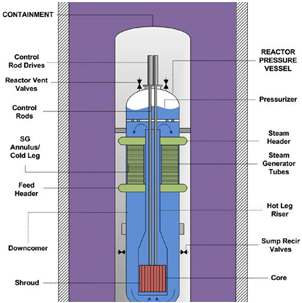I have blogged before about small modular reactors (SMR). There are different definitions of SMRs but for the purpose of this post, they generate under five hundred megawatts. The intent is to mass produce them in factories and then transport them to sites where they will be used. SMRs are still being designed, with investors and customers being sought. The U.S. Department of Energy is sinking about five hundred million dollars into research in cooperation with commercial firms.
Babcock & Wilcox had an arrangement with DoE where each would put one hundred fifty million each year to support the development of their mPower SMR. A year after the deal was signed, B&W has announced that it is scaling back its investment to fifteen million a year because they have been unable to find investors and customers. Investors are just not eager to put billions of dollars into SMR development which could take a decade or more. B&W is one of two companies working on SMRs with the DoE.
An SMR company called NuScale has had a rough time over the past few years with the SEC investigating some of the principle investors and shutting down the plant. New investors have been found and NuScale is back in business. In 2013, NuScale was selected as the second SMR company to receive DoE funds to support SMR development.
Westinghouse was also working on a SMR development project but they recently scaled back funding for the project when they lost out to B&W and NuScale for support from the DoE. Westinghouse has joined other companies in a consortium to license and build the Westinghouse SMR design for startup in 2022. Delays in the licensing will push the project back several years.
While prospects for SMRs are dimming in the United States, China is moving forward with small thorium nuclear reactor development. While the press in China is generally enthusiastic about this development, there have been articles that point out problems such as intense pressure to succeed quickly, intractable design issues, technical problems with handling molten salts in the reactor, extremely high operating temperatures, and engineering difficulties India is also very interested in developing thorium reactors. The thorium reactors is favored by Australian proponents of SMRs.
In March of this year, the Australian Department of Industry submitted materials for inclusion in an official government White Paper on energy. The DoI is advocating the development of small modular reactors to provide electricity to remote area of Australia. The Grattan Institute has proposed a line of SMRs along Australia's East Coast, connected to the national power grid.
There is current interest in placing SMRs on barges or vessels that can be towed to where the energy is needed. This could provide power for remote communities as well as oil exploration and drilling. The Russians are building a floating nuclear power station which is slated to be anchored in a harbor. MIT recently put forward a design for a nuclear power station on floating platform located six miles out to sea.
The cost of construction per kilowatt for SMRs are expected to be about the same as for the construction of a full sized conventional nuclear reactor. The electricity generated will cost about the same as convention nuclear power generation. The primary attraction is the convenience and uniformity of factory production and the ability to transport the finished reactors to remote locations. All in all, the global future of the development and operation of small modular reactors is highly uncertain.
Diagram of the NuScale Small Modular Reactor;
